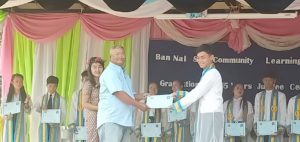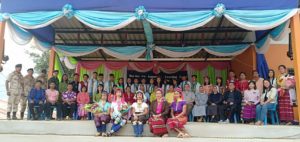 My name is Kyaw Hla Sein and I was born in Loi Kaw, capital city of the small Kayah State in eastern Burma. I completed my primary education and middle school in my native town Toungoo, located in central Burma. I completed my high school education in Myang Mya, in the southwest of Burma, Tenesary Division where I was very motivated by my teachers who spoke English.
My name is Kyaw Hla Sein and I was born in Loi Kaw, capital city of the small Kayah State in eastern Burma. I completed my primary education and middle school in my native town Toungoo, located in central Burma. I completed my high school education in Myang Mya, in the southwest of Burma, Tenesary Division where I was very motivated by my teachers who spoke English.
As a countryside boy I was very impressed to see my teachers speaking English to each other. This motivated me to study hard for DSLC examination (Division School Leaving Certificate) in order to get a chance to learn English in Spicer Memorial College, Pune, some 120 km south of Bombay, India. Finally, I passed the DSLC to attend the college.
Sadly, at that time, the Burmese military government changed it’s previous policy and no longer issued passports to citizens, as it did before when my teachers got to go and study in that same college.
I decided to try to get to the college without the proper documents.
A Chin friend told me that he could get me to my college in India so we traveled across Burma from the eastern side, close to the Thai border, to the Northwestern Chin State that shares the border with Mizoram State, India. It was there, in the Chin State border town of Te Daing, where we met a Shan schoolmate. She was also going to the Spicer Memorial College.
The Chin friend who promised to take my Shan friend and me to India left without telling us. My Shan friend and I were stranded! We got lucky though, as the younger brother of a sympathetic schoolmate took us over the Indian border to a town called Chan Phai, the second largest city in the Indian Mizoram State.
Traveling without any proper documentation we safely arrived Aizawl, the capital city of Mizoram State. There was a curfew there because the Indian and Mizos people had been having conflicts in that city. We had to stay there, under curfew, waiting, for almost 2 months.
From Aizaw my Shan friend along with a few of her friends from Burma and Mizoram and I continued to the Indian city of Si Char where we could get onto the train to Calcutta. Then it was on to Bombay and eventually to Pune.
Finally, after much travel and danger, my friends and I reached the destination of our dreams!
At Spicer Memorial College I majored in Graphic Arts and Minored in English, and was able to learn some English, but I couldn’t graduate from the college due to the Burmese military government’s attacking and closing down my family’s tin mine.
I came back to Burma due to the lack of financial support. After I arrived in my homeland, I helped my family work. Soon our living quarters were raided by the Burmese military and many people were forced into slave labor working as porters in a military column that was based in Kayah State.
I was forced to carry rice, ammunition and sometimes work as a cook. During my 6 months as a porter for the Burmese military operation I saw porters shot dead as they attempted to escape, beaten for not being strong enough to carry on, and left in the jungle to die after becoming seriously ill. I thought that the civil war in Burma would never end and that I too would die like the other porters without having the opportunity to do good things for the community.
My journey to Thailand began right after the military soldiers released me. I had already lived in India and had decided against settling in that crowded country. I carried Burmese cigars to sell on the Thai border’s black market near Mae Hong Son. I was able to tour and survey many of the villages in the region and found that the rule of law in Thailand was stable. I then decided to settle down in Mae Hong Son Province
I asked my parents to allow me to stay in Thailand to set up my new life in the more free and productive environment. But setting up a new life in Thailand was not easy in the beginning without holding any kind of ID status. The police arrested me many times as an illegal immigrant in my early stages of resettlement.
I had to work very hard for my daily survival in different villages as an elephant rider, a cook for elephant riders, a garden cleaner, a toilet pit digger, a collector of leaves to make roofs to sell, and a tree planter in the Royal Forestry areas. At the same time I was learning how to read and write Thai with the Thai Border Patrol Police who stayed near our work place.
Experiences Which Motivated the Learning Center Project
I had many different jobs in many places, going from village to village to where the work was available. I was among many migrant families who were barely surviving. This was because we could only get work for, at most, about 3 days per week when we needed much more work than that.
The children were only allowed to attend Thai schools up to Grade 6 in primary education. The children could speak, read, write and understand Thai. These children could then sometimes find jobs as housemaids, waiters, shopkeepers, etc.
On August 12, 1991, the people from the migrant community got “Hill Tribe ID Status with Blue Color” that allowed the parents to work legally and to travel freely in the Mae Hong Son municipality area. Additionally children were allowed to attend schools up to Grade 9 but not allowed to attend the high school education up to Grade 12.
A lot of children from the 26 villages in the Mae Hong Son municipality area ended up in early marriages or working as salespeople, maids, construction workers, waiters and waitresses. Some girls sadly turned to sex work while some of them ended up as minor wives for wealthy men. This become a model for other young women as some wealthy men built good houses and bought modern facilities for their minor wives. Some of the girls died from HIV as a result of sex work and being married to wealthy men.
Planning Strategy for the Long Term Project
After realizing that we had almost no hope to go back to our homeland without going back
into a war and that we must stay in Thailand for longer than we had expected, I decided to open a school for the children.
The Ban Nai Soi Community Learning Center(BNSCLC) will be a place where underprivileged students can gain functional education such as English, Burmese, Karenni , Computer Use, Typing, Organic Farming, Animal Raising and Community Development skills that can be applicable immediately after they complete 2 years in the Learning Center.
At the same time, I also thought it very important that after finishing at the Learning Center the children get a document from the Thai Education System verifying the equivalent of passing high school.
I had heard a lot about the migrant schools being raided in different parts of Thailand by the authorities and started thinking about preventing this by starting to build trusting relationships with the Thai village school teachers. 2 years before I set up our BNSCLC I started finding volunteers through the Internet for Summer Break English Training Camps for students Grade 8-9. I did this with the cooperation of the Thai teachers.
Later, I wrote the proposals to get funds to support the yearly School Sport Games as well as to get the computers and Internet connection for the students. I became the first migrant who found the possibilities to get the computers for the school. This began to change the local attitudes of the Thai villagers to a more positive view of migrant families.
Even the village chief announced the achievement in village meeting that usually held at the village temple. The village development officer himself supports what we are setting up.
The next step was to approach the local district level authority for stronger protection. I met with the Assistant District Officer to explain what I wanted to do for the target groups and he said “It is good to do this. Many migrant parents came and asked for recommendations for their children to be able to continue their education but I can not do that due to the policies of National Security Council. If you can do that I can direct the parents to attend your school.” That greatly encouraged me to start the project. In practice, the Assistant District Officers has really stood up for the BNSCLC within the frame of Thai laws as well as given us helpful suggestions.
The final step was to draw the cooperation of the Non-Formal Education Department that is in the Ministry of Education
of Thailand. The NFE is providing the education for the students who work and would like to continue their education every weekend. Everyone can learn from primary to secondary education. But the NFE director said that according to the National Security Council regulations, he can only give the recommendation of passing the Grade 12 and promised to send a high school teacher with an NFE curriculum. This academic year is the second year of the NFE sending a teacher to our BNSCLC. Out of 5 other NFE branches in the municipality area the students from our Learning Center got the highest marks on the exams.
Seeking The Start-Up Funds
Just before I set up the Learning Centre, I was working with an Education NGO called “Consortium-Thailand” that developed curriculum for primary schools in ethnic Karenni Camps. After I had worked for them for 4 years they closed their offices in Mae Hong Son while offering to extend my contract for another year. I had to refuse their offer because I urgently wanted to begin building the school. After 4 years of services with them, they left 200,000 baht(roughly $5000 USD) for me when the office closed.
I started buying the land, collecting the building materials, organizing meetings with the migrant parents, and finally preparing the land and buildings.
The biggest problem in getting funds is that almost all the local based international NGOs only support the refugees in the official UNHCR (United Nations High Commission on Refugees) refugee camps or migrant communities in Thailand which don’t hold any document or IDs.
We are stuck in the middle. In this situation, the migrant communities, like ours, who also fled to Thailand are left out or helplessly isolated in the country with limited status and support.
The only way to set up a better future for the community, without discrimination, is to try to make our own opportunities starting with whatever resources we can get.
Knowing that my own money was not enough, I wrote proposals to other donors as well.

